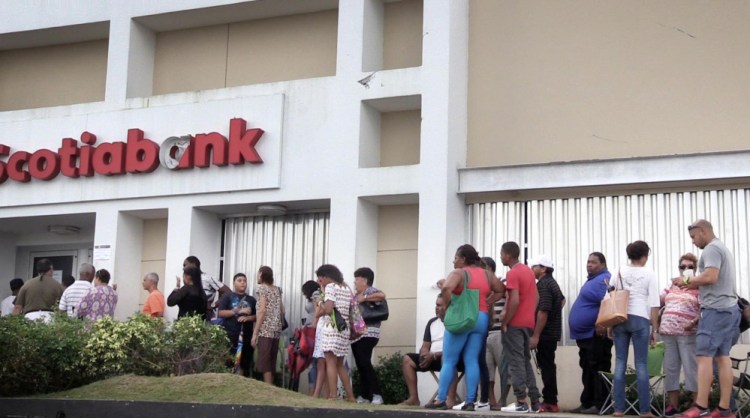SAN JUAN, Puerto Rico — One man climbs 24 flights of stairs several times a day alongside dormant elevators. Street vendors hawk plastic washboards for $20. And families outstretch their hands as crews in helicopters drop supplies in communities that remain isolated.
This is life one month after Hurricane Maria slammed into the U.S. territory on Sept. 20 as a Category 4 storm that killed at least 48 people, destroyed tens of thousands of homes and left tens of thousands of people without a job. It was the strongest hurricane to hit Puerto Rico in nearly a century, with winds just shy of Category 5 force.
“I’ve never seen anything like this,” retired schoolteacher Santa Rosario said as she scanned empty shelves at a supermarket in the capital of San Juan that had run out of water jugs – again.
Maria caused as much as an estimated $85 billion in damage across an island already mired in an 11-year recession. That has complicated and delayed efforts to restructure a portion of a $74 billion public debt load that officials say is unpayable. And it has thrust Puerto Rico’s territorial status into the international spotlight, reviving a sharp debate about its political future as the island tries to recover from flooding, landslides and power and water outages.
Maria has also put Puerto Rico into the U.S. political spotlight, with President Trump on Thursday giving himself a “10” for his response to the devastation wrought by the hurricane. Asked when the 3.4 million U.S. citizens living there could expect power to be fully restored, Trump said it will take “a while.”
“There’s never been a case where power plants were gone,” Trump said, seated alongside Gov. Ricardo Rossello in the Oval Office. “So it’s going to be a period of time before the electric is restored.”
Roughly 80 percent of power customers remain in the dark, and another 30 percent are without water. Schools remain closed. Stoplights are not operating. And while nearly 90 percent of supermarkets have reopened, many have bare rows of shelves empty of goods ranging from water to bananas to canned tuna.
“We’re not eating well,” said 28-year-old maintenance worker Pedro Lopez as he took a break from cleaning a damaged apartment complex. “It’s a lot of white rice and fried eggs.”
Near where he stood, massive tree trunks, pieces of zinc roofs and soggy items including mattresses still lined the street – a scene common across the island.
Less than half of Puerto Rico’s cellphone towers are operating, and only 64 percent of bank branches have reopened, some of them with dead outdoor ATMs whose empty screens prompt a roll of eyes from people seeking to withdraw money.
A brown haze has settled over parts of the island as more and more generators are turned on to light hospitals, homes and even the power company itself. In turn, the number of asthma cases and thefts has increased.
Newly precious generators have been stolen from places including a nursing home, an airport cargo terminal and a hospital.
Nearly 5,000 people remain in shelters, with many using rainwater to shower.
“Life has changed dramatically,” said Gilberto Del Orbe, 50, who used to install marble and gypsum board. “I’ve had no work. Everything is paralyzed.”
Send questions/comments to the editors.



Success. Please wait for the page to reload. If the page does not reload within 5 seconds, please refresh the page.
Enter your email and password to access comments.
Hi, to comment on stories you must . This profile is in addition to your subscription and website login.
Already have a commenting profile? .
Invalid username/password.
Please check your email to confirm and complete your registration.
Only subscribers are eligible to post comments. Please subscribe or login first for digital access. Here’s why.
Use the form below to reset your password. When you've submitted your account email, we will send an email with a reset code.